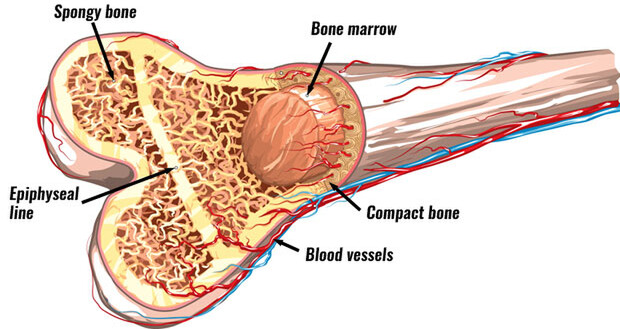A bone marrow aspirate is a test to see if blood cells in your child's bone marrow are healthy. The test will also show whether cancer cells have spread to the bone marrow from another part of the body.
Key points to remember
- bone marrow is like a factory that produces blood cells for the body
- a bone marrow aspirate is a test to see if blood cells in your child's bone marrow are healthy
- the test will also show whether cancer cells have spread to the bone marrow from another part of the body
- a bone marrow biopsy (trephine) is a test to study a piece of spongy bone marrow
- the biopsy will help find out if the bone marrow cells are healthy and whether there are any cancer cells
What is bone marrow?
Bone marrow is like a factory that produces blood cells for the body. In children, bone marrow is in the long bones, ribs, pelvis and hips. Bone marrow is in the centre of the bones and is made up of both spongy bone and liquid marrow.
Bone marrow aspirate
A bone marrow aspirate is a test to see if blood cells in your child's bone marrow are healthy. The test will also show whether cancer cells have spread to the bone marrow from another part of the body. A doctor or nurse will put a needle into the bone (usually the hip bone) and pull a small sample of liquid marrow into the syringe. Staff at the laboratory will test the marrow for cancer cells.
Bone marrow biopsy (trephine)
A bone marrow biopsy is a test to study a piece of spongy bone marrow. The biopsy will also help find out if the bone marrow cells are healthy and whether there are any cancer cells. A doctor or nurse will put a needle into the bone (usually the hip bone) and remove a small piece of the spongy bone marrow. Staff at the laboratory will then study the marrow for cancer cells.
Will my child be asleep for the procedures?
In most cases, both bone marrow aspirates and biopsies happen while your child is asleep - they have a general anaesthetic.
After the procedure
Afterwards, a small dressing will cover the area of the needle prick. The anaesthetist or another doctor can arrange medicine for any soreness. Sometimes there can be a small amount of bleeding from the needle prick, but this is not common.
The nurse will change your child's dressing and show how to press on the area to stop the bleeding. After the procedure, your child will sleep in a bed in the ward or the day stay area. Nurses will then keep an eye on them until they are fully awake. Your child will stay in the ward or day stay area until they can eat and drink and are feeling OK.
Before going home, the nurse will give instructions about removing the dressing. They will also give advice on preventing soreness.
Care at home
- redness
- heat (feels warmer than skin in other parts of the body)
- fluid oozing out
Click Donate to fund the ongoing development of the Circulating Tumor DNA project which will improve outcomes for those children already diagnosed with cancer.
Disclaimer - Content on this blog is for educational use only. Please consult your doctor or other health professional to make sure the information is right for your child.
Copyright - Please note that the information on this blog is copyright owned by The Paediatric Society of New Zealand and Starship Foundation. See copyright information at the Kids Health website.
